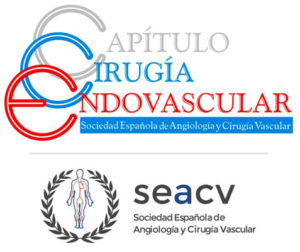The specialty has its beginnings in 1951 in Atlantic City with the I International Congress of the Society of Angiology led by F.Martorell, Leriche, Schumacher and De Bakey among others, our specialty is young compared to others, only 70 years have passed since its inception. In 1959, in the city of Barcelona, the Spanish Society of Angiology was established, led by F. Martorell. In 1977 under the Presidency of JM.Capdevila at the National Congress of Angiology held in San Sebastian, the Statutes of the Society were changed and the Spanish Society of Angiology and Vascular Surgery (SEACV) was founded. Finally, in 1978, under his presidency, the Specialty of Angiology and Vascular Surgery was officially recognized in Spain with Royal Decree 2015/1978.
This decree allows the recognition of the Specialty in MIR training, until then the title of Cardiovascular Surgery was obtained and on the other hand it is recognized as a Medical / Surgical Specialty unlike the vast majority of European countries in which Angiology and Surgery Vascular are different specialties. After the official status of the Specialty, the immediate objective was to gain recognition from other specialties, separate from Cardiac Surgery, recover Phlebology from the field of Internal Medicine and General Surgery and recover angiographic examinations from Angioradiology units. Another fundamental objective that the Specialty considers is to urgently create several Teaching Units throughout the Spanish geography.
With the development of the Specialty, the need arises to promote areas of knowledge under the name of SEACV chapters. In 1993 the Phlebology Chapter was created and in 1999 the Non-Invasive Diagnostic Chapter in order to group venous pathology within the Specialty and create non-invasive Hemodynamics laboratories in our services.
In the 1980s and 1990s, our specialty was consolidated and from the surgical point of view it focused on developing and promoting arterial surgery techniques: thromboendarterectomy and bypass with autologous vein or prosthesis, and live surgery courses led by by Dr.R.C de Sobregrau at the Valle Hebron hospital and Dr.JM Capdevila at the Bellvitge hospital.
The incorporation of Endovascular Surgery within our Specialty in the mid-nineties is preceded by some fundamental advances. In 1953 Seldinguer with the percutaneous approach to the vessels, in 1963 Fogarty with the balloon catheter that made it possible to treat arterial obstructions at a distance, in 1964 Dotter performed the first successful balloon angioplasty in a superficial femoral artery lesion and in 1990 J.C. Parodi treated successfully treated a patient with an AAA by stenting the abdominal aorta at the Cardiovascular Institute of Buenos Aires.
The vast majority of vascular surgeons at that time had a lot of training and experience in arterial surgery techniques and it was hard for us to believe that PTA/stent techniques could successfully and durably repair those arterial lesions that we treated on a daily basis. We need J.C Parodi to treat an AAA endovascularly in 1990 to awaken, incorporate and develop endovascular procedures in the field of specialty. Shortly after the first case, I myself went to see how Parodi worked in Buenos Aires and I realized that this contribution was going to change a large part of the specialty.
It is at the end of the 90s when some vascular surgeons in the country woke up and asked ourselves how we should properly train ourselves in these new procedures, how we should negotiate with the administration to obtain the appropriate technology in our surgical areas, and how to resolve the issue of interventional radiology. that was being consolidated in the angioradiology units. We promoted courses to obtain the title of director of radiological facilities for vascular surgeons, training stays abroad and live Endovascular Surgery courses, the annual course organized at the Vall d’Hebron hospital (Dr.M Matas) 2002/2014 and the SITE organized by the Hospital Clinic of Barcelona on a biennial basis (Dr. V. Riambau).
I was very aware of what was happening between Cardiac Surgery and Coronary Cardiology (the increasingly important role of cardiologists was taking shape and the impoverishment of cardiac surgery), it was a very clear example that we should avoid. The fact that our specialty was the only expert in vascular pathology in all its aspects: diagnosis, medical, surgical or endovascular treatment, and patient follow-up helped us a lot.
The idea of creating an Endovascular Surgery Chapter arose from the need to promote a forum with special dedication to these new techniques and promote the realization of works, scholarships, courses and congresses, both training and research for vascular surgeons. In the General Assembly of the SEACV Congress held in Sitges in June 2004, the creation of the SEACV Endovascular Surgery Chapter was accepted (request made by Dr.M.Matas). On 1/20/2005 the Constituent Assembly of the Chapter is held and the provisional Management Board is appointed, made up of Dr M.Matas, E. Ros, C. Vaquero, J. Serrano F.Gomez. In the city of Cadiz in June 2005, the First Congress of the Endovascular Surgery Chapter was held and the first Board formed by Dr. M.Matas, E.Ros, C. Vaquero, F. Gomez, J. Serrano, Alonso Alvarez, Collado Bueno, Escudero Rodriguez, Garcia Madrid, Lopez Quintana, Orgáz Perez-Grueso and Porto Rodriguez. Scientific Committee formed by drs. Gutierrez Alonso, Maeso Lebrun, Linares Palomino and Segura Iglesias.
Since the creation of the Endovascular Surgery Chapter in 2005, 18 years of great activity have passed, promoted by successive Boards, congresses, scholarships, registries, research projects, hybrid operating rooms that have consolidated these techniques in our daily practice. I believe that the impulse behind this project has been a great success, we must be open and prepared for the new challenges that lie ahead, such as artificial intelligence and robotics, which will significantly change our practice of medicine.
What should not change is treating patients who place their trust in each one of us to heal them with humanity and knowledge.
Barcelona January 2023.
M. Matas Docampo

















